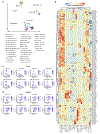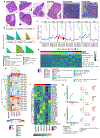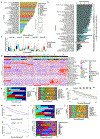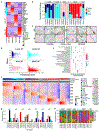A single-cell and spatially resolved atlas of human breast cancers
- PMID: 34493872
- PMCID: PMC9044823
- DOI: 10.1038/s41588-021-00911-1
A single-cell and spatially resolved atlas of human breast cancers
Abstract
Breast cancers are complex cellular ecosystems where heterotypic interactions play central roles in disease progression and response to therapy. However, our knowledge of their cellular composition and organization is limited. Here we present a single-cell and spatially resolved transcriptomics analysis of human breast cancers. We developed a single-cell method of intrinsic subtype classification (SCSubtype) to reveal recurrent neoplastic cell heterogeneity. Immunophenotyping using cellular indexing of transcriptomes and epitopes by sequencing (CITE-seq) provides high-resolution immune profiles, including new PD-L1/PD-L2+ macrophage populations associated with clinical outcome. Mesenchymal cells displayed diverse functions and cell-surface protein expression through differentiation within three major lineages. Stromal-immune niches were spatially organized in tumors, offering insights into antitumor immune regulation. Using single-cell signatures, we deconvoluted large breast cancer cohorts to stratify them into nine clusters, termed 'ecotypes', with unique cellular compositions and clinical outcomes. This study provides a comprehensive transcriptional atlas of the cellular architecture of breast cancer.
© 2021. The Author(s), under exclusive licence to Springer Nature America, Inc.
Conflict of interest statement
Competing Interests
CMP is an equity stock holder and consultant of BioClassifier LLC; CMP is also listed as an inventor on patent applications for the Breast PAM50 Subtyping assay.
JL is an author on patents owned by Spatial Transcriptomics AB covering technology presented in this paper. The remaining authors declare no competing interests.
Figures


















References
-
- Perou CM et al. Molecular portraits of human breast tumours. Nature 406, 747–52 (2000). - PubMed
Publication types
MeSH terms
Substances
Grants and funding
LinkOut - more resources
Full Text Sources
Other Literature Sources
Medical
Molecular Biology Databases
Research Materials

